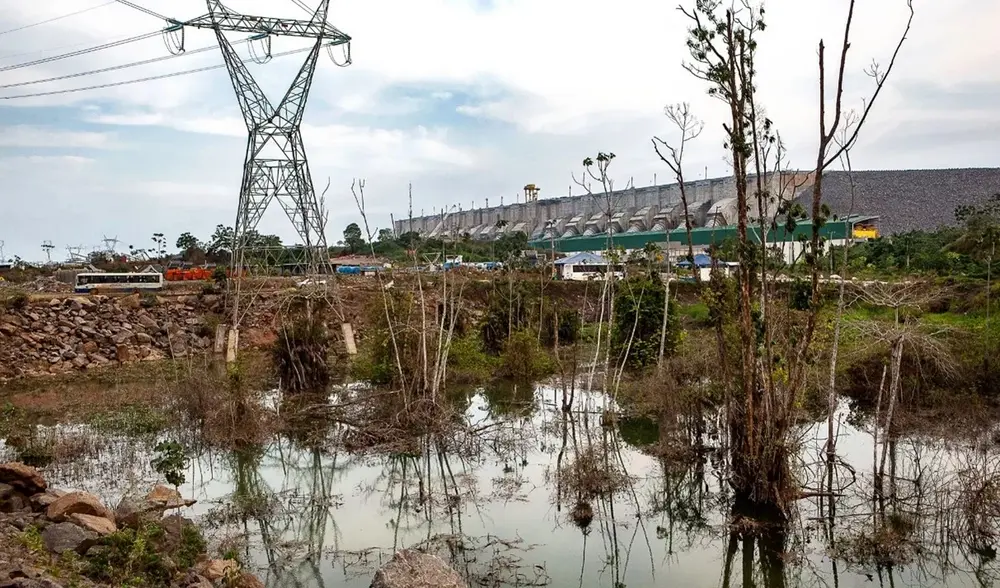Belo Monte and energy (in)justice: an analysis of the construction of the hydroelectric plant on the Xingu River

The Belo Monte Dam, located in the Brazilian Amazon, has been a highly controversial project from its inception. While it promised to bring development and clean energy to the region, its construction has led to numerous social, environmental, and economic issues.
The Belo Monte Dam is a hydroelectric project situated on the Xingu River in the state of Pará, Brazil. It was launched in 2019, and since then, it has been marred with various controversies and issues. The dam was built to provide clean energy to the region, but its construction led to deforestation, displacement of indigenous communities, and a series of legal battles that questioned its sustainability and legitimacy (Baragwanath and Bayi, 2020).
One of the main concerns about the Belo Monte Dam is its impact on the environment. The dam has led to significant deforestation in the Amazon, which has contributed to climate change and the loss of biodiversity in the region (Baragwanath and Bayi, 2020). In addition, the dam has altered the flow of the Xingu River, with studies showing an 85% reduction in flow downstream of the dam (Higgins, 2021). This has threatened the survival of various fish species, as well as the livelihoods of local communities that depend on the river for sustenance (Birindelli et al., 2009; Santos, 2009).
The construction of the Belo Monte Dam has also had a profound impact on indigenous communities in the region. According to Jaichand and Sampaio, the dam has adversely affected the rights of indigenous people, displacing them from their ancestral lands and disrupting their traditional ways of life (Jaichand and Sampaio 2022). Moreover, the dam's construction has been criticized for not adequately consulting and involving the affected communities, violating their rights to access information and participate in decision-making processes (Barros and Ravena, 2011; Estronioli and Paulino, 2015).
The issue of energy justice is also closely tied to the Belo Monte Dam. Energy justice refers to the equitable distribution of the benefits and burdens of energy production and consumption, ensuring that all individuals have access to affordable and clean energy (Jenkins et al., 2016; Sovacool et al., 2017). In the case of the Belo Monte Dam, however, the benefits of the project seem to be unequally distributed. Despite the dam's immense cost of over R0 billion (Hermes, 2021), it has been reported that the dam generates only 3% of its predicted capacity, exacerbating the energy crisis in Brazil (Hermes, 2021). Furthermore, many communities in the Amazon region still lack access to electricity, highlighting the energy inequities present in the country (Cardoso Leite and de Sousa, 2021; Rosa, 2016).
In light of the controversies surrounding the Belo Monte Dam, it is essential to recognize the importance of striking a balance between economic development and environmental conservation. As countries worldwide continue to expand their infrastructure and energy capacities, it becomes crucial to adopt more sustainable and responsible practices. Such practices should take into consideration not only the environmental impacts of projects but also their effects on local communities and their access to resources. This holistic approach can help foster a more equitable and sustainable future for all.
The Belo Monte Dam has also been the subject of numerous legal battles, with several public civil actions filed against the project for alleged environmental and social damages (Fachini, 2021). In particular, the Federal Public Ministry (Ministério Público Federal, 2023) has played a critical role in scrutinizing the dam's licensing process and ensuring that the project complies with environmental and social safeguards (Ministério Público Federal, 2023).
Despite these concerns, the Belo Monte Dam remains operational, and its impacts continue to be felt by the environment and local communities. There is an urgent need for a comprehensive and transparent evaluation of the project's true costs and benefits, as well as a reassessment of the country's energy policies and priorities. The lessons learned from the Belo Monte Dam can serve as a crucial reference point for future large-scale infrastructure projects, both in Brazil and globally.
Addressing the environmental, social, and economic consequences of the Belo Monte Dam will require concerted efforts from various stakeholders, including the Brazilian government, civil society organizations, and the private sector. Implementing rigorous environmental and social impact assessments, ensuring meaningful consultation and participation of affected communities, and promoting transparent decision-making processes can help mitigate the negative effects of such projects.
Furthermore, alternative and sustainable energy solutions should be explored and prioritized to ensure a more equitable distribution of energy resources and to minimize the environmental impacts of energy production. For instance, investing in solar, wind, and other renewable energy sources can contribute to a more diverse and resilient energy mix, reducing dependency on large-scale hydroelectric projects.
In conclusion, the Belo Monte Dam serves as a cautionary tale of the complex trade-offs and challenges associated with large-scale infrastructure projects in ecologically sensitive areas. While the dam was initially touted as a clean energy solution for Brazil, its construction has led to significant environmental degradation, displacement of indigenous communities, and questions about energy justice. As countries around the world grapple with the challenges of climate change and sustainable development, the Belo Monte Dam stands as a reminder of the need for a more comprehensive and inclusive approach to energy planning and decision-making.
References
Baragwanath, Kathryn, and Ella Bayi. 2020. “Collective Property Rights Reduce Deforestation in the Brazilian Amazon.” Proceedings of the National Academy of Sciences 117 (34): 20495-20502. https://doi.org/10.1073/pnas.1917874117.
Barros, Thiago Almeida, and Nírvia Ravena. 2011. “Representações sociais nas audiências públicas,” IV Encontro da Compolítica, April 20, Rio De Janeiro.
Norte Energia. “Belo Monte é inaugurada e está pronta para a plena operação.” 2019. www.norteenergiasa.com.br/pt-br/imprensa/releases/belo-monte-e- inaugurada-e-esta-pronta-para-a-plena-operacao-100709.
Birindelli, José Luís Olivan, Paulo Andreas Buckup, Janice Muriel Fernandes Cunha, Flavio C. T. Lima, and Jansen A.S. Zuanon. 2009.‘Avaliação do EIA - RIMA - Ictiofauna (2)’. In PAINEL DE ESPECIALISTAS: Análise Crítica do Estudo de Impacto Ambiental do Aproveitamento Hidrelétrico de Belo Monte, edited by Henri Acselrad, Diana Antonaz, Stephen Grant Baines, Edna Castro, Rosa Carmina de Sena Couto, Manoel Alexandre Ferreira Cunha, and Philip M. Fearnside, 231. Belém: INPA.
Cardoso Leite, Camila, and Vinicius de Sousa. 2021. “EXCLUSÃO ELÉTRICA NA AMAZÔNIA LEGAL: QUEM AINDA ESTÁ SEM ACESSO À ENERGIA ELÉTRICA?” São Paulo: Instituto de Meio Ambiente e Energia.
Estronioli, Elisa, and Iury Paulino. 2015. “Belo Monte: Um Rio de Direitos Violados - ÉPOCA | Amazônia.” ÉPOCA. June 5, 2015. Accessed July 27, 2022. https://epoca.oglobo.globo.com/colunas-e-blogs/blog-do-planeta/amazonia/noticia/2015/06/belo-monte-um-rio-de-direitos- violados.html.
Fachini, Tiago. 2021. “Ação civil pública: o que é, quando cabe e qual o papel do advogado.” Projuris. October 4. Accessed July 26, 2022.https://www.projuris.com.br/acao-civil-publica/.
Hermes, Felippe. 2021. “Com R0 bilhões de custo, Belo Monte gera 3% e piora crise energética.” BlockTrends - Blockchain Notícias | Investimentos | Economia (blog). October 5, 2021. Accessed July 24, 2022. https://blocktrends.com.br/com-custo-de-r100-bilhoes-belo-monte-gera-3-do-previsto-e-piora-a-crise-energetica/
Higgins, Tifanny. 2021. “Amazon’s Belo Monte Dam Cuts Xingu River Flow 85%; a Crime, Indigenous Say.” Mongabay Environmental News. March 8, 2021. Accessed July 26, 2022. https://news.mongabay.com/2021/03/amazons-belo-monte-dam-cuts-xingu-river- flow-85-a-crime-indigenous-say/
Jaichand, Vinodh, and Alexandre Andrade Sampaio. 2022. “Dam and Be Damned: The Adverse Impacts of Belo Monte on Indigenous Peoples in Brazil,” Human Rights Quarterly, 35 (2): 408–47.
Jenkins, Kirsten, Darren McCauley, Raphael Heffron, Hannes Stephan, and Robert Rehner. 2016. “Energy Justice: A Conceptual Review.” Energy Research & Social Science 11 (January): 174–82.
Ministério Público Federal. 2023 “Sobre o MPF — MPF.” Accessed July 26, 2022. http://www.mpf.mp.br/o-mpf/sobre-o-mpf.
Rosa, Taís Hemann Da. 2016. “O ACESSO À ENERGIA ELÉTRICA COMO MANIFESTAÇÃO DO DIREITO AO MÍNIMO EXISTENCIAL:” Porto Alegre: Pontifícia Universidade Católica do Rio Grande do Sul.
Santos, Geraldo Mendes dos. ‘Análise do EIA-RIMA - ICTIOFAUNA’. In PAINEL DE ESPECIALISTAS: Análise Crítica do Estudo de Impacto Ambiental do Aproveitamento Hidrelétrico de Belo Monte, edited by Henri Acselrad, Diana Antonaz, Stephen Grant Baines, José Luís Olivan Birindelli, Avenida Nazaré, São Paulo, Paulo Andreas Buckup, et al., 231. Belém: INPA, 2009.
Sovacool, Benjamin K., Matthew Burke, Lucy Baker, Chaitanya Kumar Kotikalapudi, and Holle Wlokas. 2017. “New Frontiers and Conceptual Frameworks for Energy Justice.” Energy Policy 105 (June): 677–91.
About the author

Mikael Ferreira is Master of Public Policy student at the Willy Brandt School. He has a background in public policy and international relations, with a degree in International Relations from PUC Minas. His experience is in governmental and non-governmental organizations. Mikael is dedicated to making a difference in the fields of international development and climate change.
~ The views represented in this blog post do not necessarily represent those of the Brandt School. ~